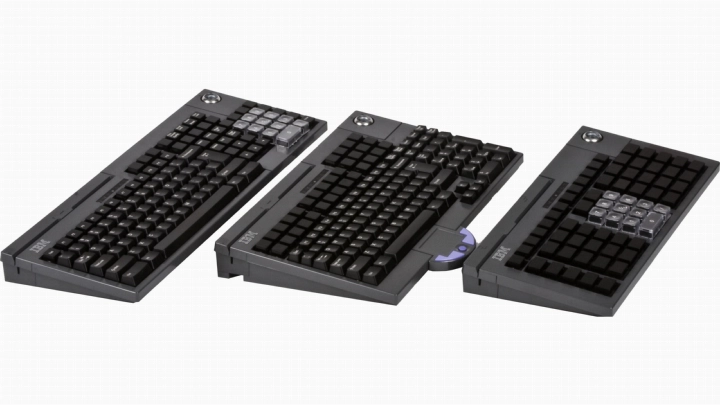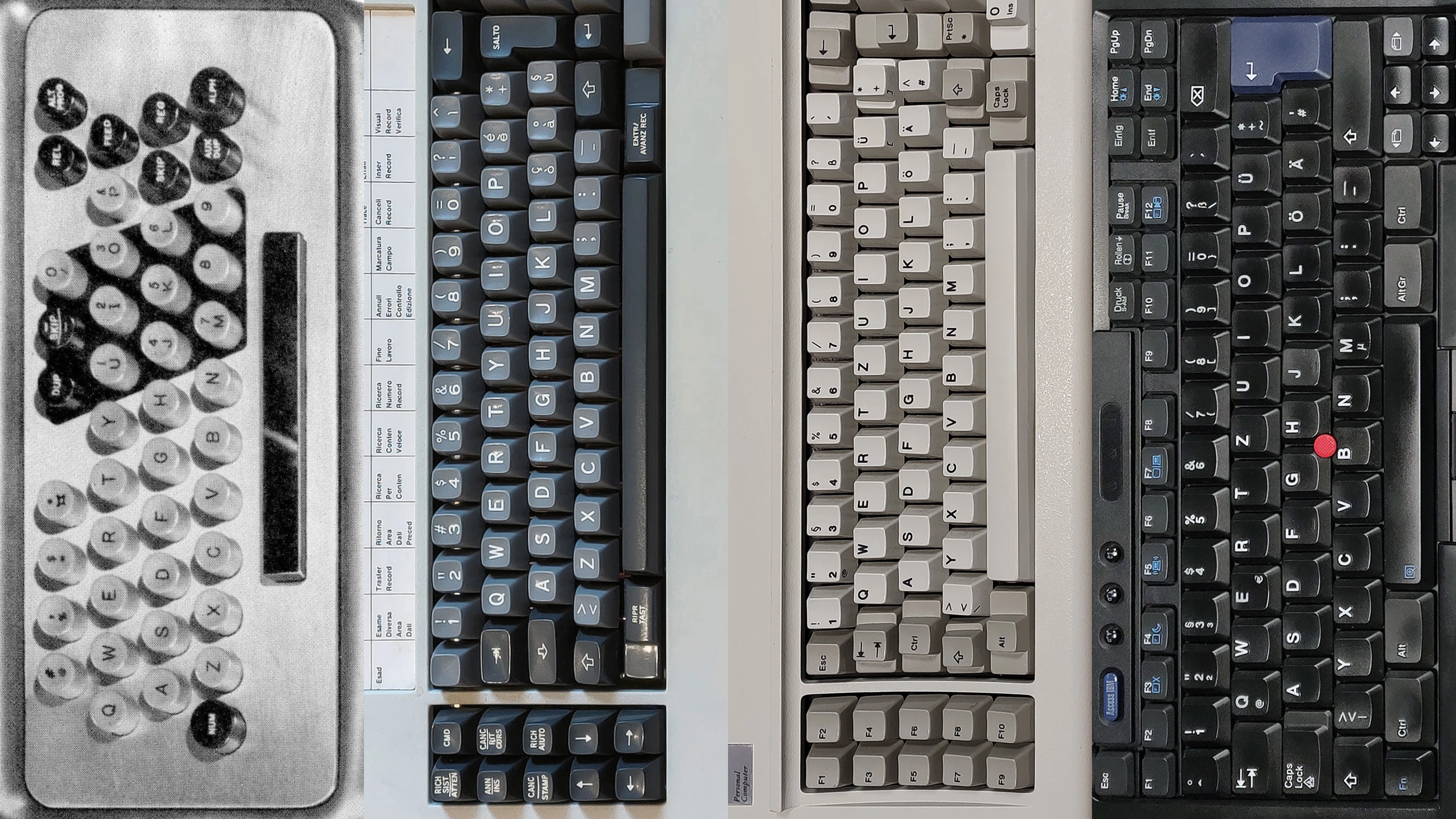A timeline of IBM keyboard history
The IBM and family keyboard timeline is an illustrated overview of some of the most important events affecting IBM, Lexmark, Unicomp, Lenovo and Toshiba Global Commerce Solutions keyboards. This includes notable keyboard releases and withdrawals, corporate history like company founding, divestures and change in OEMs, and patents. Due to their relationship and impact on the keyboards around them, host devices such as personal computers, terminals, consoles and typewriters also appear throughout the timeline. 144 events have been recorded for the "show all" versions of the timeline.
[1] The IBM Model M keyboard family is expanded to include IBM buckling sleeve based keyboards upon the introduction of the IBM Personal System/2 Model L40 SX notebook computer. L40 SX features the Model M3 keyboard assembly and optional numeric keypad. The original IBM TrackPoint (combined mouse and trackball) will also be available as an option.
[ASK] The IBM Space Saver Keyboard (Model M4) enters production around this time. It is essentially just an IBM Personal System/2 L40 SX Keyboard Assembly (M3) placed in its own cover set with a PS/2 controller card. It is notable for being the first desktop keyboard with IBM buckling sleeves.
[2] IBM introduces the Personal System/2 CL57 SX notebook computer, IBM's first laptop to have a colour display. It also introduces the buckling-sleeve Model M6 keyboard (the original Type 1 variant), an evolution of the earlier IBM PS/2 L40 SX's M3 with an updated actuation method and easier keycap removal.
[ASK] Lexmark introduces the AR10 series ODM notebook computers for third parties and later their own Lexbook brand. They sport the Lexmark Notebook Keyboard with 16mm Trackball, a Type 2 buckling-sleeve Model M6 with an integrated trackball in the bottom-right and two mouse buttons inserted in between Ctrl and Alt. Type 2 M6s are notable for introducing a 7-row physical layout to the Model M family, which would soon be refined and popularised by the then-upcoming ThinkPads as the classic ThinkPad layout.
[ASK] IBM introduces the ThinkPad 700 series notebook computers, typically considered to be the first 'true' ThinkPad (a black, bento-box styled laptop with a red pointing stick). In particular, the 700 series introduces the Type 3 variant of the buckling-sleeve Model M6 keyboard and the TrackPoint II pointing stick.
[3] IBM announces the 4693 and 4694 POS Terminals. To go with them, IBM also introduces the Retail POS (RPOS) series of buckling-sleeve Model Ms (M7, M7-1, M8, M9 and M11). RPOS keyboards are derived from a common platform and usually made by a single OEM at a given time, which contrasts the IBM 4680 era's fractured keyboard ecosystem made by IBM itself, SMK or Key Tronic.
[4] IBM introduces the Personal System/2 E, the first Energy Star-compliant PC. To go with it, the pearl-white IBM Quiet Touch Keyboard with TrackPoint II (Model M4-1, also known as IBM Space Saver Keyboard with TrackPoint II) is also introduced. M4-1 is an extension of M4, but with an integrated TrackPoint II pointing stick, and was in fact the first non-laptop IBM keyboard with such a device.
[5] IBM introduces the ThinkPad 500 series monochrome subnotebooks. 500 in turn introduces the Type 4 variant of the buckling-sleeve Model M6-1 keyboard. Compared to most other M6/M6-1 types, Type 4 has a compressed layout, smaller key unit sizes and (on average) lower-gauge sleeves to suit the 500-series' very small size.
[6] IBM introduces the IBM ThinkPad 750 series notebook computers. 750 series in turn introduces the Type 5 variant of the buckling-sleeve Model M6-1 keyboard, a revision of the Type 3 design that most notably sports an outer frame and hinges to allow them to mount to the host laptop to act as its inner cover and lifts to provide access to major system components.
[ASK] The Winbook XP series of notebooks begins appearing in marketing. They sported Lexmark-produced keyboards, which happen to be the earliest known examples of the Type 6 buckling-sleeve Model M6-1 variant. Type 6s are similar to Type 4 in that they are more compacted than the other types, but Type 6 retains standard sleeve gauges and key unit sizes and makes less layout compromises.
[ASK] IBM introduces the ThinkPad Space Saver Keyboard with TrackPoint II around this time, a raven black version of the existing buckling-sleeve Model M4-1. This keyboard is only a cosmetic variant, but as the name implies, it is associated with the IBM ThinkPad family as it will be available with ThinkPad docking solutions. It will later also be available with some IBM Industrial Computers and in general.
[ASK] Apple introduces the Newton OS 2.0 for its Newton MessagePad series personal digital assistants that promises better handwriting recognition and supports an external keyboard. The Apple Newton MessagePad Keyboard (model X0044) is launched to coincide with this, but it is especially interesting since it is derived from the IBM ThinkPad 500's Type 4 Model M6-1 buckling-sleeve keyboard assembly and is presently the only known Apple-branded Model M.
[3] IBM introduces the 4820 SurePoint Solution Flat Panel Display, an attachment originally for IBM 4694 POS Terminals. The display in turn could support a 32-key keypad attachment that was originally called the IBM SurePoint 4820 Monitor Keypad and MSR Extension. This keypad is considered to be the beginning of the Pre-Modular POS (PMPOS) series of buckling-sleeve Model Ms. 4 types of 4820-style keypads would eventually be introduced.
[7] IBM introduces the original Compact ANPOS Keyboard (CANPOS). It is a 133/134-key keyboard with an integrated pointing device and optionally an MSR that manages to pack all this functionality into a form-factor that is roughly as wide as a TKL. It is considered to be within the PMPOS series of buckling-sleeve Model Ms.

IBM introduces the Modular POS (MPOS) series of buckling-sleeve Model Ms as successors to RPOS, finally shaking up IBM POS keyboard design for the first time since 1993. MPOS at this point includes the IBM Modular 67-Key POS Keyboard, IBM MANPOS Keyboard and IBM MCANPOS Keyboard. The "modular" in their names refers to how some of the keyboard's extra functionality is user removable and replaceable.
[ASK] The IBM Modular 67-Key POS Keyboard with LCD Display is introduced as the fourth and final member of the MPOS series of buckling-sleeve Model Ms, replacing the RPOS-era Model M8 and thus sometimes known as the "M8-e". It is presently the latest known IBM buckling sleeve keyboard design.
- D. E. Larsso - File:IBM PS2 L40SX.jpg [accessed 2021-12-04]. License/note: CC BY-SA 4.0.
- Jack @ laptop.pics - donated photos. License/note: CC BY-NC-SA 4.0.
- IBM - ftp://public.dhe.ibm.com [accessed 2025-03-05]. License/note: archived from IBM public FTP & used under fair dealing.
- Brandon @ clickykeyboards.com - 1997 IBM model M4-1 keyboard with trackpoint (84H8470) 18-JUL-1997 and external numpad (84H8537) + spare keyboard assembly [accessed 2022-08-20]. License/note: https://deskthority.net/wiki/Help:Contents#Copyright.
- AD Maggs @ Wikimedia - File:Thinkpad 500 & 510 Machines.jpg [accessed 2025-05-16]. License/note: CC BY-SA 4.0 (cropped).
- ASK Keyboard Archive - P/N 66G0121 (1994, Lexmark) [accessed 2023-06-04]. License/note: photos saved from volatile eBay listing, used under fair dealing.
- doomsday_device - donated photos. License/note: CC BY-NC-SA 4.0.

